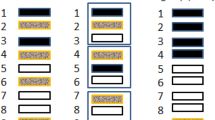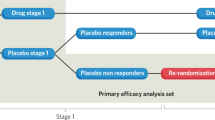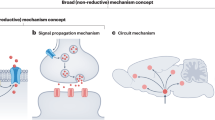Key Points
-
The costs of treating brain diseases are high, because many of these conditions are common, and we lack good treatments for the majority
-
Drug development for these diseases is hampered by a paucity of experimental and reporting rigour and a lack of statistical power, leading to overoptimistic interpretation of the literature
-
Recognition that we have a problem is the first step towards finding a solution
-
We have started to provide transparency in experimental design and rigour of reporting in preclinical publications, and we now need to bring similar quantifiable measures to funding decisions
-
Multicentre, randomized, blinded, powered and appropriately governed preclinical trials conducted by expert consortia offer an opportunity to ensure that only the very best drug candidates reach clinical trial
Abstract
Translational neuroscience is in the doldrums. The stroke research community was among the first to recognize that the motivations inherent in our system of research can cause investigators to take shortcuts, and can introduce bias and reduce generalizability, all of which leads ultimately to the recurrent failure of apparently useful drug candidates in clinical trials. Here, we review the evidence for these problems in stroke research, where they have been most studied, and in other translational research domains, which seem to be bedevilled by the same issues. We argue that better scientific training and simple changes to the way that we fund, assess and publish research findings could reduce wasted investment, speed drug development, and create a healthier research environment. For 'phase III' preclinical studies—that is, those studies that build the final justification for conducting a clinical trial—we argue for a need to apply the same attention to detail, experimental rigour and statistical power in our animal experiments as in the clinical trials themselves.
This is a preview of subscription content, access via your institution
Access options
Subscribe to this journal
Receive 12 print issues and online access
$209.00 per year
only $17.42 per issue
Buy this article
- Purchase on Springer Link
- Instant access to full article PDF
Prices may be subject to local taxes which are calculated during checkout


Similar content being viewed by others
References
OECD Health Data 2012. OECD [online], (2012).
Olesen, J. & Leonardi, M. The burden of brain diseases in Europe. Eur. J. Neurol. 10, 471–477 (2003).
Olesen, J. et al. The economic cost of brain disorders in Europe. Eur. J. Neurol. 19, 155–162 (2012).
Rafii, M. S. & Aisen, P. S. Recent developments in Alzheimer's disease therapeutics. BMC Med. 7, 7 (2009).
McDonagh, M., Peterson, K., Carson, S., Fu, R. & Thakurta, S. Drug Class Review: Atypical Antipsychotic Drugs: Final Update 3 Report (Oregon Health and Science University, 2010).
National Institute on Drug Abuse. Principles of Drug Addiction Treatment: A Research-Based Guide 19 (NIH Publication No. 12-4180, 2012).
National Institute of Mental Health. Breaking Ground, Breaking Through: The Strategic Plan for Mood Disorders Research 85 (NIH Publication No. 03-5121, 2003).
Wang, Y. R., Alexander, G. C. & Stafford, R. S. Outpatient hypertension treatment, treatment intensification, and control in Western Europe and the United States. Arch. Intern. Med. 167, 141–147 (2007).
Weber, M. A. & Giles, T. D. Inhibiting the renin–angiotensin system to prevent cardiovascular diseases: do we need a more comprehensive strategy? Rev. Cardiovasc. Med. 7, 45–54 (2006).
Strong, K., Mathers, C. & Bonita, R. Preventing stroke: saving lives around the world. Lancet Neurol. 6, 182–187 (2007).
Donnan, G. A. et al. How to make better use of thrombolytic therapy in acute ischemic stroke. Nat. Rev. Neurol. 7, 400–409 (2011).
Lees, K. R. et al. Time to treatment with intravenous alteplase and outcome in stroke: an updated pooled analysis of ECASS, ATLANTIS, NINDS, and EPITHET trials. Lancet 375, 1695–1703 (2010).
Krumbhaar, E. B. & Krumbhaar, H. D. The blood and bone marrow in Yellow Cross gas (mustard gas) poisoning: changes produced in the bone marrow of fatal cases. J. Med. Res. 40, 497–508.3 (1919).
Haddad, R. et al. Induction chemotherapy followed by concurrent chemoradiotherapy (sequential chemoradiotherapy) versus concurrent chemoradiotherapy alone in locally advanced head and neck cancer (PARADIGM): a randomised phase 3 trial. Lancet Oncol. 14, 257–264 (2013).
[No authors listed] Tissue plasminogen activator for acute ischemic stroke. The National Institute of Neurological Disorders and Stroke rt-PA Stroke Study Group. N. Engl. J. Med. 333, 1581–1587 (1995).
Stockwell, B. R. The Quest for the Cure: The Science and Stories Behind the Next Generation of Medicines (Columbia University Press, 2011).
Kling, J. Fresh from the biologic pipeline—2010. Nat. Biotechnol. 29, 197–200 (2011).
Morgan, S., Grootendorst, P., Lexchin, J., Cunningham, C. & Greyson, D. The cost of drug development: a systematic review. Health Policy 100, 4–17 (2011).
Stroke Therapy Academic Industry Roundtable (STAIR). Recommendations for standards regarding preclinical neuroprotective and restorative drug development. Stroke 30, 2752–2758 (1999).
Stroke Therapy Academic Industry Roundtable II (STAIR-II). Recommendations for clinical trial evaluation of acute stroke therapies. Stroke 32, 1598–1606 (2001).
Fisher, M. & Stroke Therapy Academic Industry Roundtable. Recommendations for advancing development of acute stroke therapies: Stroke Therapy Academic Industry Roundtable 3. Stroke 34, 1539–1546 (2003).
Fisher, M. et al. Enhancing the development and approval of acute stroke therapies: Stroke Therapy Academic Industry Roundtable. Stroke 36, 1808–1813 (2005).
Fisher, M. et al. Recommendations from the STAIR V meeting on acute stroke trials, technology and outcomes. Stroke 38, 245–248 (2007).
Fisher, M. et al. Update of the Stroke Therapy Academic Industry Roundtable preclinical recommendations. Stroke 40, 2244–2250 (2009).
Saver, J. L. et al. Stroke Therapy Academic Industry Roundtable (STAIR) recommendations for extended window acute stroke therapy trials. Stroke 40, 2594–2600 (2009).
O'Collins, V. E. et al. 1,026 experimental treatments in acute stroke. Ann. Neurol. 59, 467–477 (2006).
Macleod, M. R., O'Collins, T., Howells, D. W. & Donnan, G. A. Pooling of animal experimental data reveals influence of study design and publication bias. Stroke 35, 1203–1208 (2004).
Macleod, M. R., O'Collins, T., Horky, L. L., Howells, D. W. & Donnan, G. A. Systematic review and meta-analysis of the efficacy of melatonin in experimental stroke. J. Pineal Res. 38, 35–41 (2005).
Macleod, M. R., O'Collins, T., Horky, L. L., Howells, D. W. & Donnan, G. A. Systematic review and metaanalysis of the efficacy of FK506 in experimental stroke. J. Cereb. Blood Flow Metab. 25, 713–721 (2005).
Macleod, M. R. et al. Sources of bias in animal models of neurological disease. J. Neurol. Neurosurg. Psychiatry 77, 135–136 (2006).
van der Worp, H. B., Sena, E. S., Donnan, G. A., Howells, D. W. & Macleod, M. R. Hypothermia in animal models of acute ischaemic stroke: a systematic review and meta-analysis. Brain 130, 3063–3074 (2007).
Macleod, M. R. et al. Evidence for the efficacy of NXY-059 in experimental focal cerebral ischaemia is confounded by study quality. Stroke 39, 2824–2829 (2008).
Sena, E. S. et al. Factors affecting the apparent efficacy and safety of tissue plasminogen activator in thrombotic occlusion models of stroke: systematic review and meta-analysis. J. Cereb. Blood Flow Metab. 30, 1905–1913 (2010).
Jerndal, M. et al. A systematic review and meta-analysis of erythropoietin in experimental stroke. J. Cereb. Blood Flow Metab. 30, 961–968 (2010).
Janssen, H. et al. An enriched environment improves sensorimotor function post-ischemic stroke. Neurorehabil. Neural Repair 24, 802–813 (2010).
O'Collins, V. E. et al. Preclinical drug evaluation for combination therapy in acute stroke using systematic review, meta-analysis, and subsequent experimental testing. J. Cereb. Blood Flow Metab. 31, 962–975 (2011).
Steward, O., Popovich, P. G., Dietrich, W. D. & Kleitman, N. Replication and reproducibility in spinal cord injury research. Exp. Neurol. 233, 597–605 (2012).
Scott, S. et al. Design, power, and interpretation of studies in the standard murine model of ALS. Amyotroph. Lateral Scler. 9, 4–15 (2008).
O'Collins, V., Donnan, G., Macleod, M. & Howells, D. in Animal Models for the Study of Human Disease (ed. Conn, M.) 532–569 (Academic Press, 2013).
Sena, E. S., van der Worp, H. B., Bath, P. M., Howells, D. W. & Macleod, M. R. Publication bias in reports of animal stroke studies leads to major overstatement of efficacy. PLoS Biol. 8, e1000344 (2010).
McCabe, C. et al. Differences in the evolution of the ischemic penumbra in stroke-prone spontaneously hypertensive and Wistar-Kyoto rats. Stroke 40, 3864–3868 (2009).
Letourneur, A., Roussel, S., Toutain, J., Bernaudin, M. & Touzani, O. Impact of genetic and renovascular chronic arterial hypertension on the acute spatiotemporal evolution of the ischemic penumbra: a sequential study with MRI in the rat. J. Cereb. Blood Flow Metab. 31, 504–513 (2011).
Vesterinen, H. M. et al. Improving the translational hit of experimental treatments in multiple sclerosis. Mult. Scler. 16, 1044–1055 (2010).
Ankolekar, S., Rewell, S., Howells, D. W. & Bath, P. M. The influence of stroke risk factors and comorbidities on assessment of stroke therapies in humans and animals. Int. J. Stroke 7, 386–397 (2012).
O'Collins, V., Donnan, G., Macleod, M. & Howells, D. Hypertension and experimental stroke therapies. J. Cereb. Blood Flow Metab. 33, 1141–1147 (2013).
Howells, D. W. et al. Different strokes for different folks: the rich diversity of animal models of focal cerebral ischemia. J. Cereb. Blood Flow Metab. 30, 1412–1431 (2010).
Wang-Fischer, Y. (Ed.) Manual of Stroke Models in Rats (CRC Press, 2008).
Stroke Therapy Academic Industry Roundtable (STAIR). Recommendations for standards regarding preclinical neuroprotective and restorative drug development. Stroke 30, 2752–2758 (1999).
Rewell, S. S. et al. Inducing stroke in aged, hypertensive, diabetic rats. J. Cereb. Blood Flow Metab. 30, 729–733 (2010).
Zhu, H. et al. Annexin A2 combined with low-dose tPA improves thrombolytic therapy in a rat model of focal embolic stroke. J. Cereb. Blood Flow Metab. 30, 1137–1146 (2010).
Tsilidis, K. et al. Evaluation of excess significance bias in animal studies of neurological diseases. PLoS Biol. 11, e1001609 (2013).
Chalmers, I. & Glasziou, P. Avoidable waste in the production and reporting of research evidence. Lancet 374, 86–89 (2009).
Howells, D. W., Sena, E. S., O'Collins, V. & Macleod, M. R. Improving the efficiency of the development of drugs for stroke. Int. J. Stroke 7, 371–377 (2012).
Ioannidis, J. P., Ntzani, E. E., Trikalinos, T. A. & Contopoulos-Ioannidis, D. G. Replication validity of genetic association studies. Nat. Genet. 29, 306–309 (2001).
Dirnagl, U. & Fisher, M. REPRINT: International, multicenter randomized preclinical trials in translational stroke research: it is time to act. Stroke 43, 1453–1454 (2012).
Dirnagl, U. & Fisher, M. International, multicenter randomized preclinical trials in translational stroke research: it's time to act. J. Cereb. Blood Flow Metab. 32, 933–935 (2012).
Reimer, K. A. et al. Animal models for protecting ischemic myocardium: results of the NHLBI Cooperative Study. Comparison of unconscious and conscious dog models. Circ. Res. 56, 651–665 (1985).
Bailey, K. R. Detecting fabrication of data in a multicenter collaborative animal study. Control. Clin. Trials 12, 741–752 (1991).
Bath, P. M., Macleod, M. R. & Green, A. R. Emulating multicentre clinical stroke trials: a new paradigm for studying novel interventions in experimental models of stroke. Int. J. Stroke 4, 471–479 (2009).
Kochanek, P. M. et al. A novel multicenter preclinical drug screening and biomarker consortium for experimental traumatic brain injury: operation brain trauma therapy. J. Trauma 71 (Suppl.), S15–S24 (2011).
O'Brien, T. J. et al. Proposal for a “phase II” multicenter trial model for preclinical new antiepilepsy therapy development. Epilepsia 54 (Suppl. 4), 70–74 (2013).
Macleod, M. R. et al. Good laboratory practice: preventing introduction of bias at the bench. Stroke 40, e50–e52 (2009).
Macleod, M. R. et al. Reprint: Good laboratory practice: preventing introduction of bias at the bench. J. Cereb. Blood Flow Metab. 29, 221–223 (2009).
Macleod, M. R. et al. Reprint: Good laboratory practice: preventing introduction of bias at the bench. Int. J. Stroke 4, 3–5 (2009).
Kilkenny, C., Browne, W. J., Cuthill, I. C., Emerson, M. & Altman, D. G. Improving bioscience research reporting: the ARRIVE guidelines for reporting animal research. PLoS Biol. 8, e1000412 (2010).
Landis, S. C. et al. A call for transparent reporting to optimize the predictive value of preclinical research. Nature 490, 187–191 (2012).
Begg, C. et al. Improving the quality of reporting of randomized controlled trials. The CONSORT statement. JAMA 276, 637–639 (1996).
Schulz, K. F., Altman, D. G., Moher, D. & the CONSORT Group. CONSORT 2010 statement: updated guidelines for reporting parallel group randomized trials. Ann. Intern. Med. 152, 726–732 (2010).
[No authors listed] Announcement: reducing our irreducibility. Nature 496, 398 (2013).
Kelner, K. Medicine: playing our part. Sci. Transl. Med. 5, 190 (2013).
Author information
Authors and Affiliations
Contributions
All three authors researched the data for the article, provided a substantial contribution to discussions of the content, wrote the article, and reviewed and/or edited the manuscript before submission.
Corresponding author
Ethics declarations
Competing interests
The authors declare no competing financial interests.
Rights and permissions
About this article
Cite this article
Howells, D., Sena, E. & Macleod, M. Bringing rigour to translational medicine. Nat Rev Neurol 10, 37–43 (2014). https://doi.org/10.1038/nrneurol.2013.232
Published:
Issue Date:
DOI: https://doi.org/10.1038/nrneurol.2013.232
This article is cited by
-
Motor Rehabilitation Provides Modest Functional Benefits After Intracerebral Hemorrhage: a Systematic Review and Meta-Analysis of Translational Rehabilitation Studies
Translational Stroke Research (2023)
-
Time and Brain Region-Dependent Excitatory Neurochemical Alterations in Bilateral Common Carotid Artery Occlusion Global Ischemia Model
Neurochemical Research (2023)
-
Predictive validity in drug discovery: what it is, why it matters and how to improve it
Nature Reviews Drug Discovery (2022)
-
Microglia and monocytes in inflammatory CNS disease: integrating phenotype and function
Acta Neuropathologica (2022)
-
Impact of ambient temperature on inflammation-induced encephalopathy in endotoxemic mice—role of phosphoinositide 3-kinase gamma
Journal of Neuroinflammation (2020)



